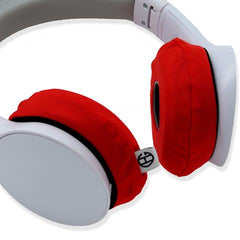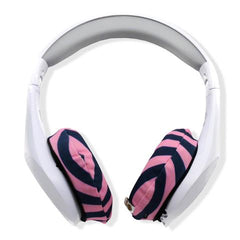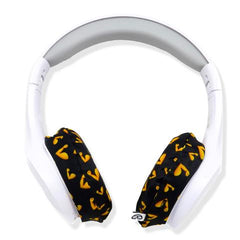Earmuff Headphones: Bluetooth

Here’s something you probably didn’t know (and probably don’t need to know but hey, pop-quiz!), the man behind the modern earmuff was Chester Greenwood. Frustrated at how cold his ears would get when skating the ponds of his native Farmington, Maine, Greenwood was equally irritated by his apparent allergy to the ‘protective wool caps with ear covers’ that the Smithsonian.com describes as being ‘typically used as ear protectors at the time’.
The Smithsonian goes on to say that whilst Greenwood can’t be credited with having invented the earmuff, it was his patented V-shaped swivel hinge that kept the muff pressed to the ear. The rest is history. The earmuff put Farmington on the map, made a lot of money for Chester Greenwood AND has helped to keep countless ears toasty warm over the years.
When you think of earmuffs you might imagine cold winter scenes: icy ponds, children sledging, thick cotton wool clumps of snow high in the tree branches, the pull of a warm fire in a country pub. Mittens! you might think of those, too, and hot chocolate topped with flame-roasted marshmallows. All very lovely, yes, and all very twee, but it’s a million miles away from what you probably need right now: Bluetooth earmuff headphones.
Technology has moved on quite a bit since Chester Greenwood’s day, so if he were to step onto a commuter train or observe the comings-and-goings of urban streets, he’d probably be forgiven for thinking that earmuffs were still as popular as they were in his day. After all, headphones do look like a sort of industrial, steam-punk earmuff. Maybe that’s how we’d explain the technology to him: Mr Greenwood, sir, it’s a kind of musical earmuff.
Only that’s not entirely true, is it?
Headphones don’t actually make a huge difference to the temperature of our ears in the biting cold. In fact, some people actually find them to be more uncomfortable in the colder weather. Synthetic leather isn’t designed to stop the bitter blow of a cold wind. If you have on-ear headphones, too, then there’s not even a complete seal over the ear to keep the cold air out.

Musical earmuffs, earmuff headphones or whatever you want to call them aren’t actually a bad idea. They make a lot of sense. The global headphone industry is estimated to be worth $13 billion and in a large part of the world, cold weather in the winter months is as sure a thing as death and taxes — so it’s not exactly a ridiculous idea to combine the two. Bluetooth headphones are, after all, designed to be used on the move. And putting headphones over a hat doesn’t always work. One always seems to ride up and need pulling down. It’s not just outside that earmuff headphones would come in handy. What about public transport: commuters sitting next to doors and windows that might be in a near-constant state of opening and closing? Airliners, university libraries and shopping centres can all have aggressive air conditioners. Maybe you just have cold ears.
Fluffy headphones do make sense.
But many of the Bluetooth earmuff headphones that you’ll find online are disappointing. You won’t see the likes of Bose, Beats, Sennheiser, Wilkins PX etc advertising their latest big release — musical earmuffs.
Most musical earmuffs are sold for young girls. They’re a kind of headphone-lite which no doubt serves the 7 to 14 age bracket as a sort of Apple or Beats pre-cursor. Those aimed at adults (women in particular) aren’t using top-of-the-range headphones, and that’s fine for some people. Not everyone is an audiophile and it’s not everyone that wants or needs to spend hundreds of pounds on a pair of headphones. But what about those of us who don’t want to sacrifice sound quality for the sake of warmer ears in winter?

The first thing to do is pick the Bluetooth headphone BEFORE the earmuff. Doing it the other way around is understandable (often you don’t have a choice) but ridiculous. The headphone is THE most important element here and not the fake-fur glued onto the cushions.
If you already have a headphone that you love, then that’s perfect. It’s ideal actually. Good job.
Scroll down to the next paragraph.
If you’re still looking for your headphone, then the choice can be overwhelming. Whatever you choose is going to be dependent on your lifestyle, your budget, the types of thing you listen to, what’s comfortable, durable and what other people have been saying about them. Ask friends, read online reviews but in particular pay attention to sites like TrustedReviews.com, WhatHiFi, CNET etc as they’ll often give a pretty complete idea of what you can expect from a pair of headphones.
One headphone that we were really excited about last year was Sony’s WH1000XM3. We paired them with sweat-proof headphone covers and hit the gym, but wherever you’re listening with them on their noise-cancellation is super-impressive, and they’re comfortable AF. They were a big hit with online reviewers and tech journalists on release, too. Similarly, the Bose QuietComfort 35 II’s deserve a mention for design and comfort alone. Although, not everyone always rates Bose for sound quality (if you’re really into that thing). If you can’t make up your mind between on-ear or over-ear headphones, then we drew up a list of our contenders at the end of last year. When Audio-Technica released the impressive ATH-M50xBT they impressed a lot of people with it. Further down the price scale, Skullcandy (who’ve never really overly impressed before) made the Hesh3 headphone a pretty solid release back in 2017.
The point is: take your time choosing your headphones.
Pick them FIRST.
Add the earmuff AFTERWARDS.
With that in mind, we’d like to introduce you to EarSnugz.
EarSnugz are earmuffs for headphones. They literally turn ANY headphone into a musical earmuff. Bose, Beats, Sennheiser, Sony, Philips, Wilkins PX, Master Dynamic, Plantronics, Skullcandy, Monster — even the £8 ones you got off eBay.
Thanks to their hypoallergenic and thermal grade super soft material, they’ll keep your ears toasty without compromising the sound of your headphones. There’s nothing novelty about these either — just subtle, snuggly and super soft designs that will keep Jack Frost from nipping at your toes (and ears).






